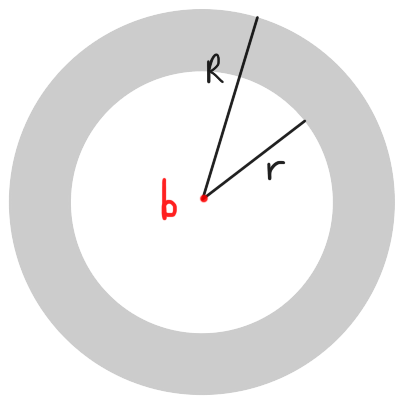
Figure 1: The annulus $\Ann(b,r,R)$ centered at $b$ of inner radius $r$ and outer radius $R$.
Home | Assessment | Notes | Index | Worksheets | Blackboard
Over the previous week we developed an understanding of what is called the local picture of a holomorphic function: if $f : \ball(b,R) \to \C$ is holomorphic then $f$ can be expanded as a power series centered at $b$ with radius of convergence at least $R$. This is an incredible amount of regularity to get from merely the assumption that $f$ is differentiable at every point in $\ball(b,R)$.
Our next goal is to develop the theory of functions holmorphic on an annulus. Given $b \in \C$ and $0 \le r < R$ we write \[ \Ann(b,r,R) = \{ z \in \C : r < |z-b| < R \} \] for the annulus of inner radius $r$ and outer radius $R$.
The function $f(z) = 1/z$ is holomorphic on the annulus $\Ann(0,0,R)$. However, there is no power series centered at 0 equal to $f$ throughout $\Ann(0,0,R)$ because any such power series would be holomorphic on $\ball(0,R)$ and would therefore have a contour integral of zero over the circle of radius $R/2$ centered at 0, whereas the contour integral of $f$ over the same contour is $2 \pi i$. We will therefore need a broader type of expansion for functions on annuli.
Although we cannot expand holomorphic functions on annuli in terms of power series, we will see that a more general expansion in terms of Laurent series is always possible.
A Laurent series centered at $b$ with coefficients $a_n$ is an expression of the form \[ \sum_{n=-\infty}^\infty a_n (z-b)^n = \sum_{n=0}^\infty a_{-n} \dfrac{1}{(z-b)^n} + a_0 + \sum_{n=1}^\infty a_n (z-b)^n \] and we say that a Laurent series converges at a specific $z \in \C$ if both of the series \[ \sum_{n=1}^\infty a_{-n} \dfrac{1}{(z-b)^n} \qquad \sum_{n=1}^\infty a_n (z-b)^n \] converge.
The coefficients of a Laurent series are indexed by integers and therefore corerspond to a map from $\Z$ to $\C$.
Fix a map $a : \Z \to \C$. The power series \[ \sum_{n=1}^\infty a_n (z-b)^n \] has (as all power series do) some radius of convergence $R \ge 0$. The power series \[ \sum_{n=1}^\infty a_{-n} w^n \] has radius of convergence $\rho \ge 0$. Taking $w = 1/(z-b)$ we conclude that \[ \sum_{n=1}^\infty a_{-n} \dfrac{1}{(z-b)^n} \] converges whenever $|z-b| > 1/\rho$. Putting $r = 1/\rho$ we have proved that the Laurent series \[ \sum_{n=1}^\infty a_{-n} \dfrac{1}{(z-b)^n} + a_0 + \sum_{n=1}^\infty a_n (z-b)^n \] converges whenever $|z-b| > r$ and $|z-b| < R$. If $r < R$ then the Laurent series converges on the annulus $\Ann(b,r,R)$. If $r > R$ the Laurent series does not converge anywhere.
Our main theorem is that every holomorphic function on an annulus can be represented by a Laurent series.
If $f$ is holomorphic on the annulus $\Ann(b,r,R)$ then $f$ can be represented by a Laurent series \[ f(z) = \sum_{n=0}^\infty a_{-n} \dfrac{1}{(z-b)^n} + a_0 + \sum_{n=1}^\infty a_n (z-b)^n \] on all of $\Ann(b,r,R)$. Moreover \[ a_n = \frac{1}{2\pi i} \int\limits_\gamma \dfrac{f(z)}{(z-b)^{n+1}} \intd z \] for all $r < s < R$ and all $n \in \Z$ where $\gamma(t) = b + se^{it}$ on $[0,2\pi]$.
We call the Laurent series representing $f$ on $\Ann(b,r,R)$ the Laurent series of $f$. The portion \[ \dfrac{a_{-1}}{(z-b)} + \dfrac{a_{-2}}{(z-b)^2} + \cdots = \sum_{n=1}^\infty a_{-n} \dfrac{1}{(z-b)^n} \] is called the principal part of $f$ on $\Ann(b,r,R)$.
We will not prove Laurent's theorem. The proof is somewhat similar to the proof of Taylor's theorem. Note, however, that we cannot conclude that $a_n = f^{(n)}(b) / n!$ in this case. Indeed $f$ may not even be defined at $b$!